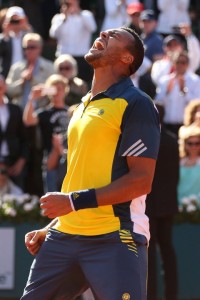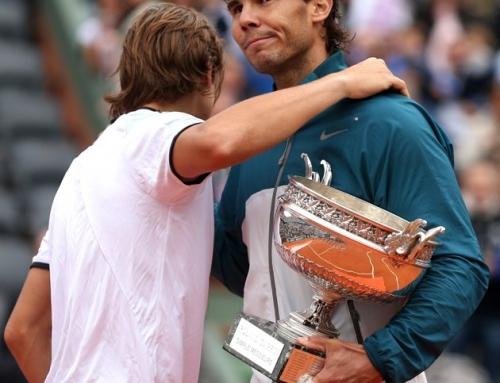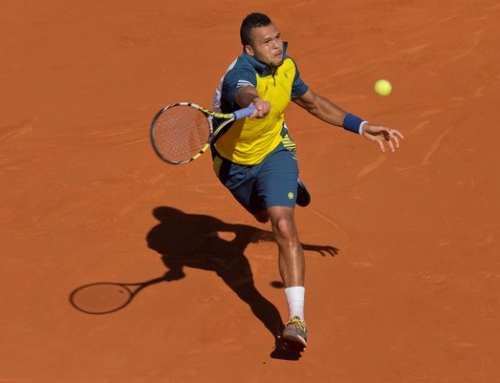 Outside the other members of the big 4, if there are two players Federer would prefer not to see in a draw, it’s Jo-Wilfried Tsonga and Tomas Berdych. Both have big serves. Both hit hard off the ground. Both have given Federer troubles in Slams.
Outside the other members of the big 4, if there are two players Federer would prefer not to see in a draw, it’s Jo-Wilfried Tsonga and Tomas Berdych. Both have big serves. Both hit hard off the ground. Both have given Federer troubles in Slams.
Remember when Federer has that semifinal streak? Federer had reached 23 consecutive semifinals. It’s tough enough just to play 23 consecutive Slams, but to reach the semis each time? Who broke that streak? In 2010, that man was Tomas Berdych at Wimbledon. In 2011, Federer again lost in the quarterfinals of Wimbledon, this time to Jo-Wilfried Tsonga. In 2012, Federer was lucky and neither man was in his half of the draw, so this made his road to the finals that much nicer, and indeed, he won the title.
For a period of time, Tsonga was working without a coach, and that was fine, for a while. But he had struggled to beat top ten foes, so he decided to work with a coach. He went with Roger Rasheed who once coached Lleyton Hewitt, and another Frenchman, Gael Monfils.
Tsonga had reached the quarterfinals without losing a set. Federer opened with a break, but was broken back, and then broken again. Federer’s rhythm, disrupted by a fall against Gilles Simon in the fourth round, failed to return as Tsonga played explosive tennis holding over 70% of first and second serves while Federer couldn’t break 60% on his own, creating a bad combination for success.
Federer would lose in straight sets 75 63 63.
In the other quarterfinal played today, Tommy Robredo, who struggled to 3 consecutive 5-setters all from 2 sets to love down, had no answers for his Spanish compatriot as Ferrer continued to advance without dropping a set. Ferrer steamrolled to a 62 61 61 win. Ferrer reaches yet another Slam semi having reached the French semi and the US Open semi last year. This year, he reached the Australian Open semifinal.
But this marks Ferrer’s best chance to reach a Slam final ever. In the past, players like Djokovic or Nadal or Federer or Murray blocked Ferrer’s progress to the finals, but the diminutive Spaniard actually has a winning record against Tsonga.
Of course, this opportunity is also great for Tsonga in a country that desperately wants a French winner of the French Open (a subversive way of doing this is to convert the French Open into an indoor event, thus robbing Nadal of his favorite surface).
Despite having less than great results against Ferrer, Tsonga is the kind of player that should be able to trouble Ferrer. He moves faster than Berdych, but has similar power off the ground and off the serve. In the past, mental toughness has been an issue. Perhaps under Rasheed, Tsonga has finally put the pieces together. Both will be considered underdogs to Nadal or Djokovic if either of the two reach the finals as they are predicted to do.
The remaining quarterfinals will be played tomorrow with Djokovic facing Haas, and Nadal facing Wawrinka. The higher seed is favored in both, though Haas and Wawrinka still have outside shots at defeating their rival, but both will need exceptional days while having the favorites play underneath their best. Haas may have beaten Djokovic recently, but if Djokovic can get his game settled down (and it’s only been periodically good, say, against Dimitrov). Wawrinka has the more daunting task as Nadal appears to be playing better, and Wawrinka not only has come off a five-setter, but he has also never taken a set off of Nadal.
Wawrinka, like Tsonga, has a new coach in Magnus Norman who coached Robin Soderling to Nadal’s only loss on clay. Has Norman taught his pupil enough that he can beat the much favored Spaniard? Probably not, but it would be interesting to see.




![[French Open] The tactics of the Djokovic-Nadal semifinals](https://www.essentialtennis.com/wp-content/uploads/2013/06/20130607nole-500x383.jpg)
![[French Open, SF] David Ferrer defeats Tsonga in straight sets to reach first Slam final](https://www.essentialtennis.com/wp-content/uploads/2013/06/20130607ferrer-500x383.jpg)
![[French Open, SF] Nadal escapes epic 5-setter with win over Djokovic, to compete for 8th title](https://www.essentialtennis.com/wp-content/uploads/2013/06/20130607rafa-500x383.jpg)
